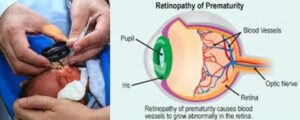Retinopathy of prematurity among infants is caused by abnormal growth of the blood vessels of the retina. When a baby is born prematurely, retinal blood vessels can grow abnormally, causing damage to the retina.


Retinopathy of Prematurity (ROP) is a blinding disorder affecting children caused by abnormal growth of the blood vessels of the retina. This disease affects children who are prematurely born before 34 weeks of pregnancy (against the normal term of 38 – 42 weeks). Children with retinopathy are born underweight with weight ranging much below 2000 gms. When a baby is born prematurely, retinal blood vessels can grow abnormally, causing damage to the retina. Both the eyes of the child may be affected which can eventually lead to life-long impaired vision or blindness.
Causes and effects:
Usually, the retinal blood vessels in the child’s eye starts developing after the first 16 weeks of pregnancy. The development of the eyes is fastest during the last 12 weeks of a full-term pregnancy. However, if the child is prematurely born, there could be inadequate development of the child’s retinal blood vessels. This leads to non-supply of enough oxygen and nutrients and abnormal formation of blood vessels. The abnormal retinal blood vessels can cause bleeding, retinal detachment, visual impairment, and blindness.
Identification
The Retinopathy in the new born infant is identified by a dilated fundus examination around 4 weeks after birth. Examination may be preponed by 1 week (That is at 3 weeks) in case of very low birth weight babies and those born very early.
Management:
Management of cases of ROP involves coordination between, the neonatologist, ophthalmologist and the NICU staff
Process of examination
For clinical examination of the child for retinopathy syndrome, few drops of diluted drops are administered to the child 30 – 45 minutes before the actual examination. This process enables observation of abnormalities inside the eye of the infant.
- The retina of the child may be fully matured ensuring that the baby is safe. Follow-up checks are advised after 6 months.
- The retina of the child may not be fully developed.
- The ROP has affected the child but is not severe. Such children will be advised to close follow-ups.
- The last possibility is ROP has severely affected children thereby necessitating the need for laser / intraocular injections/surgery.
Benefits of Laser :
ROP is a very rapidly progressing disease and hence any delay in treatment will severely impair the sight of the child. The recovery period of the ROP disease depends upon the child’s systemic condition, which once it gets stabilized, ensures total recovery. If the ROP has not affected the central part of the retina, the child will regain full vision. Only in severe cases the success of treatment will be lesser.
Statistically, it is noted that in the USA 3.9 million children are born every year of which around less than 1% of children have ROP. Most children get cured with only around 500 – 600 children becoming blind in the USA alone.
Awareness in India:
Around 38 million children are born every year in India of which nearly around 33% of the children are prematurely born. In India, the awareness of this disease is not widely spread, especially in rural areas.


Dr.Tandava Krishnan
Vitreo retinal surgeon
MaxiVision super specialty Eye Hospital
Hyderabad, Telangana state











